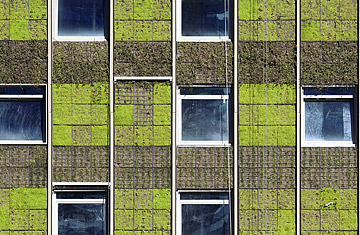
Living wall of the Intercontinental Hotel in Santiago, Chile
You've heard, no doubt, about the planet-friendly benefits of putting gardens on rooftops, but what about installing plants on the sides of buildings? So-called living walls can make for stunning works of botanical art, can't-miss-'em signs of environmental stewardship. But does this architectural trend actually help cut down on buildings' energy use?
The answer depends on the gardens, which are sprouting up worldwide, everywhere from museums and corporate headquarters to airports and highway overpasses. And the new designs keep growing larger. In October, Pennsylvania's nonprofit Longwood Gardens captured the title of North America's largest living wall with a vertical garden measuring 3,590 sq. ft., which is 50% bigger than that of the continent's previous record holder, PNC Bank in Pittsburgh. Now Longwood is being dwarfed by the InterContinental Hotel in Santiago, Chile, which planned to formally unveil its 17,000-sq.-ft. wall — about the size of six doubles tennis courts — early this month.
When done right, a living wall can significantly reduce a building's heating and cooling costs, albeit not as much as a green roof can. The wall treatments — which consist of a bunch of modular metal or plastic casings that can be removed for inspections or repairs — also cost more, easily climbing over $100 per sq. ft., compared with $15 to $40 per sq. ft. for green roofs.
And since rain generally doesn't fall sideways, irrigation is both necessary and tricky. Designers have to use drip-irrigation systems and often rely on electronic monitoring devices to make sure the plants don't dry out. Irrigating with recycled water and installing native plants can help cut down on resource use. The Santiago hotel incorporates three species. Patrick Blanc, the French botanist who kicked off the vertical-garden trend, often uses more than 250 species on his walls.
George Irwin, CEO of Green Living Technologies, the Rochester, N.Y., company that created the Santiago tapestry, admits that clients aren't hanging living walls for the energy-cost savings. "Green roofs provide a faster return on the investment," he says. "But everybody can see your green wall. It is marketing genius."
Minsuk Cho, an architect who dressed the outer and inner walls of Seoul's Ann Demeulemeester store in a dense carpet of foliage, says greening walls maximizes the opportunity to create a better urban environment, but you can't plant them and walk away. "Just like any garden, maintaining a green wall takes commitment," Cho says. "It shouldn't be considered as a building material but more like a pet." A very large and thirsty one.
This article originally appeared in the December 13, 2010 issue of TIME.
